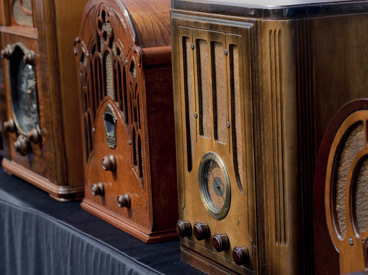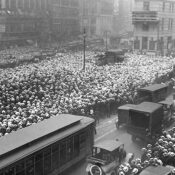
by Alva Johnston and Fred Smith
Washington Irving created the first great American legend of Halloween in “The Legend of Sleepy Hollow.” In his short story, a vain, superstitious schoolmaster is so terrorized by a prankster disguised as a headless horseman that he flees his village and never returns.
When actor, writer, and director Orson Welles planned a Halloween broadcast for 1938, he knew Americans weren’t going to be impressed with an imaginary horseman from hell. Instead, he presented horror with a modern tone. His adaptation of H. G. Wells’ War of the Worlds was scrupulously planned to give the impression of an unscripted radio broadcast, with panicked announcers, realistic sound effects, and careful editing. (At one point, a “reporter” at the landing site describes the Martians firing a lethal heat ray that is moving toward him, closer and closer. Suddenly his microphone goes dead and eight seconds of stunned silence pass before a shaken station announcer comes on the air.)
Welles had unlimited faith in his dramatic abilities, but the success he achieved that night was far beyond anything he would hoped to have reached.
“The most puzzled people in the United States on Sunday night, October 30, 1938, were the traffic policemen of New Jersey. There were plenty of frightened citizens in America at that time, but the most confused ones were the motorcycle cops on the highways between New York and Philadelphia. At about 8:15 or 8:20 P.M., most of the traffic over those roads suddenly went wild.”
The account comes from a Post biography from 1940, “How To Raise a Child: The Disturbing Life — to Date — of Orson Welles.”
“Hundreds of automobiles began to flash along at speeds which normally indicate gangsters leaving scenes of assassination. But there were family parties in most of the cars: the women and children couldn’t all be gun molls and child racketeers. When a motorcycle man tried to overhaul one speeding auto, he was passed by two or three others. The stampede was in all directions. Nobody would stop for a policeman’s hail. Now and then, a traffic man would catch an incoherent shout that there was an ‘invasion’ or that ‘the world was coming to an end.’
“There were puzzled policemen in station houses all over the country, as demands came over the telephone for gas masks and information as to the safest places to hide from the enemy. The second most puzzled group were the switchboard operators, as the telephones suddenly went crazy and began to rave deliriously. Next came the clergy; priests were startled by the rush to get confessions under the wire, and Protestant ministers astonished at the interruption of their sermons by demands for prayers to avert the impending doom of the world. Fourth in the order of puzzlement may well have been hospital attendants who were called on to handle the nervous wrecks and falling-downstairs cases.
“Welles had nearly finished the broadcast before he detected that something was wrong. Through a glass partition in the studio he observed the entrance of several policemen, and he also notice unwonted activity at a battery of telephones.
“As soon as the broadcast was over, attendants hurried over to inform him that there were long-distance calls for him.
“The first message was a threat of death from a chamber-of-commerce official of Flint, Michigan, who asserted that the population of Flint had scattered far and wide and that it would take days to reassemble. The next message offered statistics on the number of broken tibias and fibulas in people from Western Pennsylvania. Hundreds of dollars were paid to A.T.& T. that night for the privilege of swearing at Welles. The thing grew serious as the death toll mounted. It was around twenty at ten P.M. Later research indicated that there had been no fatalities, but at the time Welles regarded himself as a mass murderer.”
Irving meant us to smile at his fear-ridden schoolmaster. Welles only wanted to make the flesh creep among his listeners. He never intended to make the broadcast an illustration of how easy it was to stampede Americans.
Much of Welles’ effectiveness, according to his biographer, came from his mixture of the fantastic and mundane.
“His success in scaring the nation resulted from the capable handling of the old familiar earmarks of credibility. He gave names, addresses, occupation and other minute details; identified each farm hamlet, turnpike, knoll, swamp and creek in the terrain which the Martian monsters swept over; christened every cop and village loafer who got mixed up in the interplanetary unpleasantness.
“It was this change of pace from the particular to the cosmic that paralyzed the reasoning powers of his listeners. The seasoning of little facts of geography and personal identity cause Welles’ public to swallow his wildest absurdities.”
In fairness, though, we should consider how the atmosphere of the times contributed to the panic:
• The year was hardly one of reassuring calm. Hitler had taken over control of the German Army, seized Austria and Czechoslovakia, and just a week before Welles’ broadcast, issued his first threat against Poland. Meanwhile, fascist armies were making steady progress over the countrysides of Spain, China, and Africa. Americans could see the next world war over the horizon, and it was moving faster than they thought possible.
• It was hard to confirm or deny rumors. On Sunday evening, when Americans began hearing about Martians, the next newspaper was about 12 hours away. Most Americans couldn’t telephone to confirm the rumors: Only a third of households had phones at the time. Many did tune their radio to the NBC system and The Chase & Sanborn Hour as usual, but for some, this wasn’t enough reassurance.
• The time of year was also important. Autumn seems to awaken a sense of the macabre. Cool days, unexpected twilight, the rustling of dry leaves, and the roar of wind through bare tree limbs have always inspired thoughts of the fantastic and supernatural.
• Lastly, we should bear in mind all the changes Americans of 1938 had seen. The country had lost many of its old certainties, which had insulated prior generations. Americans were living with ideas and technology that wasn’t just impossible when they were young, but unimaginable. If our great bull-market economy could fail, if the government was attempting to repair the market, if Prohibition could be repealed—why wouldn’t we believe that Martians landed in New Jersey?
Become a Saturday Evening Post member and enjoy unlimited access. Subscribe now




Comments
People who believe Martians are landing will believe anything, including man-made global warming.